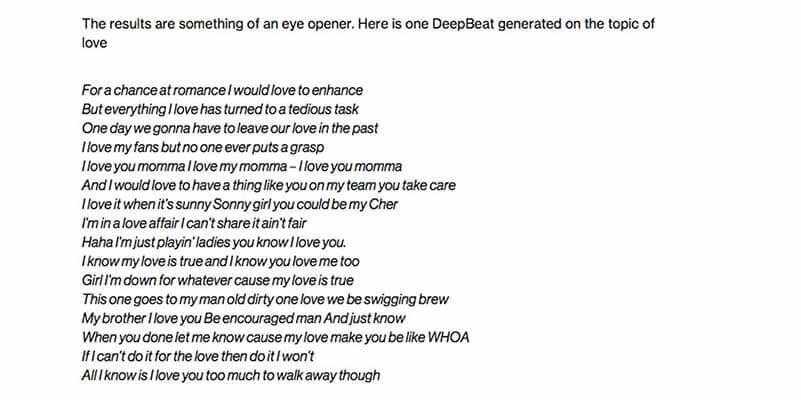Throughout human history, technology has been the harbinger of change. Be it architecture or medicine, transportation or industry; trending developments in technology in each age have defined all human courses of action. In our previous posts, we have ventured across modern-day technological innovations in detail. Today, we will explore the connection of the human mind and machine, which could be a reality very soon. From prosthetic limbs that respond to your thoughts, robots that write their own rap to 3D printed skin and Terminator-like artificial intelligence, every element of science fiction we were fascinated by as kids is coming to life, and I am here to tell you how. In this post, we will look at some stellar innovations which depict the extent of creativity the human mind can achieve. Let’s have a look at five trending developments in technology that are set to change the course of human history
1. Prosthetic limbs will answer to your thoughts – the connection of mind and machine
Remember Dr. Octavious from Spider-man? He could control his artificial tentacles by thought! Imagine if war veterans with prosthetic limbs could do that. How simplified their lives could be. But is that all? Is it also possible that the reverse happens? What if these machines take control of our minds? Scary, isn’t it? Engineers from Johns Hopkins University have created a revolutionary prosthetic enhancement. These guys, who work relentlessly at the university’s applied physics lab, have developed a robotic arm with 26 joints. It can curl up weights up to 45 pounds and is controlled by a person’s mind, just like a regular arm! I believe it is a remarkable achievement and puts us one step closer to removing boundaries between the connection of man and machine. The creation is already helping Les Baugh, who as a teenager lost both arms after an electrical accident. He is 59 now and recently underwent a surgery at Johns Hopkins. The remaining nerves from his missing arms were remapped allowing brain signals to reach the prosthetic arm. The custom socket picks up brain signals from Mr Baugh’s arms and transfers them to the prosthetics. Thus, he can move his arms by only thinking about the movements. Isn’t that remarkable?
Mike McLoughlin, who is the chief engineer of research and exploratory development at the lab, has some interesting insight into the development. He said that as the remapped nerves settled and grew deeper, it is even possible for Mr. Baugh to feel some sensation is his prostheses. I was amazed to hear this. He added that each arm has over 100 sensors and other amputees have been able to feel the texture of these modular prosthetic limbs (MPLs). Modular means these arms are very flexible. They can be broken off and built up according to individual specific needs. For instance, a hand amputee (missing a part of the arm) as well as a person with an entire missing arm can avail the benefits of this prosthetic marvel. Same goes for quadriplegics or stroke survivors who lose their ability to move some or all body parts.
I consider this to be a remarkable step forward for medicine and healthcare technology, and one of the most important trending developments in technology. According to UN statistics, around 15% of the world’s population lives with disabilities. That is about a billion people. I believe many of them will embrace this arm as a means to a new and better life. Such a reality is still a bit far as the development is currently due for approval by the Food and Drugs Administration (FDA). The approval can only be given after successful clinical trials. McLoughlin believes that considerable cost cutting is required to make the arm marketable. Currently each one costs USD500,000, which is quite high. But I think as approvals come in and mass production takes place, costs will decrease as with any other technology and the arm will be available to the public in the time to come. What do you think?
2. Forget “Astalavista Baby!”
Modern day machines will write their own rap lyrics! You may think that rap has only a very urbane and hep audience with tattoos and piercings but you are far from the real deal. Scientists and literary authorities believe that the ancient skill of creating and performing spoken rhyme is only alive today due to the popularity of rapping. Adam Bradley, an English professor at the University of Colorado, has described rap as intricate structures of sound and rhyme which create some of the most scrupulously formal modern-day poetry. The intriguing point put forth by computer scientists is that the highly structured nature of rap makes it especially amenable to computer analysis. They believe that an automated rap-generating algorithm pushes the boundaries of machine creativity! This brings us to a very interesting speculation: If machines can analyze raps, can they also create their own? Thanks to Eric Malmi and his friends, the answer is yes! These guys from the University of Aalto in Finland have trained a machine learning algorithm to recognize the salient features of a few rap lines and then choose another line which rhymes in the same way and also on the same topic! The result: high quality rap lyrics that compete with human-generated ones! Malmi and his group call the algorithm DeepBeat.
It uses assonance rhyme schemes in its process as this is the rhyme scheme which distinguishes rap from other kinds of poetry. It is essentially the repetition of similar vowel sounds (such as crazy and baby). For initial training, they started with a database of over 10,000 songs from over 100 rap artists. The words are first converted to phonemes. Rhymes are then found by scanning the phonemes and looking for similar vowel sounds while ignoring consonant sounds and spaces.
This algorithm has also allowed them to find a measure regarding the complexity of rhymes in rap lyrics. It has also let them rank all rap artists based on their rhyming complexity and density. The top three are Inspectah Deck, Rakim, and Redrama. Eminem features low on this list because of his unique style of bending words to fit the rhymes. The algorithm does not allow for such a technique at the moment. I believe that this metric is an interesting way to compare automated raps and human generated ones. The guys also tested the algorithm with a goal to analyze a sequence of lines from a rap lyric and then select the next line from a list that contains randomly chosen lines from other songs along with the actual line. The success rate recorded was a staggering 82%! The raps generated by DeepBeat have a rhyming density that is higher than any human rapper. The outperformance quotient was 21%. The major drawback is ironically the huge stress on rhyme schemes which allows for a drip in the coherence of story-telling. I guess they have come this far and, by what they have achieved, this flaw will be solved in the time to come. Machines writing their own raps is commendable, but I still prefer Eminem! Now I wouldn’t like him to buy the machine and use it in case he suffers from writers’ block.
See also: Last week trending in technology: Google, Facebook & Iron Man
3. Change songs while you run? Now let Spotify choose soundtracks according to your running speed!
In an event on last Wednesday 20th of May, Spotify revealed a “running” option for its mobile app users. If you don’t know what I am getting at, then imagine this: You are on your morning jog. You are gaining pace slowly. The blood is pumping and you yearn for an increase in the tempo of your music. What do you do? Let me guess: go through your playlist and select that favourite DJ Tiësto mix which keeps you in the right spot! Spotify aims to nullify this and allow for a completely smooth and enriching running experience through this update.
The new Spotify app uses sensors in your mobile device. They update it with your running pace. You can very well pick the track which suits your pace or just let Spotify pick it for you. The choice will be made according to your personal preferences. It has also been reported that Spotify is working on creating original music which adapts automatically to your running pace and changes its tempo and intensity accordingly. Six tracks have already been created and one of them is by DJ Tiësto himself. So if you are a Tiësto fan and a fitness freak that likes to keep in shape, then this is one of the trending developments in technology you need to be tracking. Spotify also plans to integrate with apps such as Nike and RunKeeper to tap better into the potential. The app update will be rolled out in the US, UK, Germany, and Sweden this week and soon in other major countries. I believe this new feature brings in a new level of automation for music, so that we do not get distracted during our workouts! What do you think?
4. After ruling the cosmetic industry for over a 100 years, L’Oreal announces its next big idea: 3D-printed skin
In our previous posts, we saw how 3D printing was revolutionizing different aspects of healthcare and other business sectors. In a bid to make use of these trending developments in technology, French cosmetics giant L’Oreal is partnering with bio-engineering startup Organovo to produce 3D-printed human skin. Its main goal is to use this skin in product tests. I guess this is a better option than animal testing! Organovo has been in the news due its claims of being able to 3D-print a human liver. This is its first tie-up with the cosmetics industry. The question, however, is that why does a cosmetics firm need to print skin? L’Oreal was not clear with its explanations. L’Oreal grows skin samples from tissues donated by plastic surgery patients. It produces more than 1000000 square centimetres of skin samples every year! It said that the partnership will bring in advanced in vitro methods for evaluating product safety and performance. It also mentioned that the potential of such technology is limitless. It couldn’t be any more ambiguous. Well, it is clear that 3D-printed skin will have revolutionary implications in healthcare in terms of cheaper skin grafts and other cosmetic surgeries. Yet, in the cosmetics sector, anything apart from using 3D printed skin for trials and tests seems scary.
Adam Friedman, a consultant dermatologist at the Harley Street Dermatology Clinic, agrees to the science behind it, i.e., using 3D printing methods with human cells. However, he fails to understand any kind of application in the cosmetics industry. I guess only time will reveal what the real agenda behind all this is. Till then, skin-graft wait-lists can grow more hopeful! “Tissue donation is a life-enhancing and often life-saving gift of bone, skin, heart valves, veins, and connective tissue. These gifts are surgically removed after the heart stops beating. There is no waiting list for tissue recipients”. I guess the main agenda here is to establish a more secure and safe channel of product testing and evaluation, and also cutting down on donation receipts! What do you say?
5. Computers will have “common sense” in the coming decade, thanks to Google’s on-going research in artificial intelligence
I know what you are thinking. I know each one of us is scared by the possibilities of artificial intelligence, which movies like the Terminator have shown us. It all begins with this one possibility: Can they be developed to think like us? If yes, then how much time would it take for them to think in a more logical way than us? Leading AI scientists have predicted that computers will develop common sense within a decade. Professor Geoff Hinton is the leading authority when it comes to mapping the growth and possibilities of artificial thought and intelligence. He was hired by Google two years ago to assist on intelligent operating systems. Recently, he stated that the internet giant was on the brink of developing algorithms with the capacity for logic, natural conversation, and even flirtation. A new type of algorithm called the ‘Thought Vector’ is being designed by Google which encodes thoughts as a series of numbers. Although the idea of capturing thoughts is extremely controversial, Hinton thinks that it will help crack two of the central challenges in artificial intelligence, which are:
- Mastering natural, conversational language
- The ability to make leaps of logic
According to what he said, I get a picture of the movie ‘Her’ where Joaquin Phoenix falls in love with his intelligent operating system. A world where human and machine interaction is not limited by instruction and response seems very much possible now. All the Tony Stark fans out there can all have their own versions of Jarvis in the time to come! I would certainly love one! Wouldn’t you? The idea seems more and more plausible each day because of the recent positive developments in AI. Richard Socher, an AI scientist at Stanford University, has developed a program called NaSent which was been taught to recognize human sentiment by being trained on 12000 sentences taken from a film review on Rotten Tomatoes.
The main idea behind Thought Vectors was to improve translation platforms such as Google Translate, which uses dictionaries to translate individual words and searches previously translated documents to find typical translations for phrases. To remove the errors of faulty grammar and nonsensical sentences, the concept of Thought Vectors was introduced to work at a higher level and extract something closer to the actual meaning! However, major challenges are yet to be met. For instance, Hinton points out that irony will be very hard to get for these AI models. There is also a real existential threat to humans which has been pointed out by tech geniuses such as Elon Musk. The idea that intelligent machines may move out of human control and take hostile action (Terminator style!) is still far-fetched but is becoming a possible reality each passing day, courtesy of these developments.
However, I believe the core idea of allowing computer programs to learn how to carry out work by training on huge datasets rather than programming in inflexible code is quite fascinating. Imagine a simple and easy life with machines doing much of the heavy lifting and being worthwhile friends who listen to all your blabber while you focus on doing things which enrich your own existence. Ideal, don’t you think?
Conclusion
As a trend watcher, I see one consistent trend which fosters all others. It is the increasing range of human imagination and creativity. We have become smarter in the last century. The growth measure is higher than all history combined. Each day, we take giant leaps and venture into seemingly impossible avenues and use our will and imagination to make them possible. Who would have thought ten years down the line that prosthetics and skin would be printed? Even Terminator fans would say that they imagined the world taken over by machines in, say, 2100 or 2200 AD. The technology-driven society has crunched this estimated time gap and accelerated mankind on the path of rapid technical growth.
These trending developments in technology may be from different sectors and may cater to very different needs but the bottom line is the same in each case: Modern-day technology, in the time to come, will focus on simplifying everyday things such as smoothening your jogging experience to even filling a want for companionship. The scares may be many, they always are, but ultimately the choice is ours. We have to be careful all along and make sure that each question about authenticity, ethics, security, and privacy is answered before we approve of these remarkable developments. Do you agree?
Share via:






